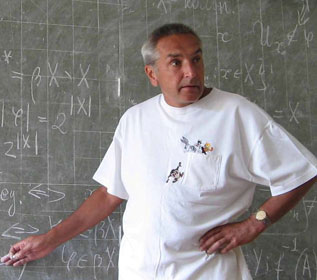devoted to the 60th anniversary of the birth
of Igor Volodymyrovych Protasov

Igor Volodymyrovych Protasov traces his origins from the famous Ukrainian family of Piddubnyi, known for the strongest man of his time as well for many good teachers. The grand-grand-grand-father of I. Protasov was a priest in Poltava region whose daughter (i.e., Protasov's grand-grand-mother) worked as a teacher in Nizhyn gymnasium. Protasov's grand-mother also was a school teacher while his father and mother were economists. After graduating from the economical faculty of Kyiv State University (soon after the Second World War) they were sent as young specialists in socialist economics to Western Ukraine.
There in Lviv, on 7th of September 1953 their son Igor Protasov was born. In the childhood the Igor often stayed with his grand-mother who lived in Yavoriv, a town near Polish border, not far from Lviv. Actually, his primary eduction (the first three years of school) Igor Protasov obtained in Yavoriv, in the famous gymnasium named after Osyp Makovei.
In 1965 Protasov's family returned back to Kyiv. In 1970 Igor Protasov graduated from the secondary school and entered the Faculty of Cybernetics at Taras Shevchenko Kyiv State University. In 1975 he graduated from the university and in 1975-1977 studied on post-graduate studies under supervision of Viktor Charin, a representative of the famous Kyiv algebraic school leaded by S.N.Chernikov.
In 1977 he started to work as an assistant at the chair of mathematical fundamenta of Cybernetics. In 1978 he defended his Ph.D. Thesis ``Topological properties of the lattices of subgroups of a group'' and obtained the degree of Kandidat of Sciences in Physics and Mathematics. One of the main results of his dissertation was a solution of a known problem of Glushkov, Platonov, and Maltsev on the (non)existence of a topologically prime locally compact nilpotent group. These results attracted attention of mathematical community, in particular, in 1979 they were distinguished by a Prize and Medal of the Presidium of Academy of Sciences for young scientists. Further investigations in this direction consisted his Doktor of Science dissertation ``Local method and varieties of topological algebras'' defended by I.Protasov in 1990 in Minsk. Since that times scientific interests of I.Protasov extended substantially and now they include such areas as semigroups of ultrafilters, $T$-sequences in groups, extremal topologies on groups, Ramsey Theory and its application in Combinatorics of Groups.
The last decade his scientific investigations are dominated by Asymptology (a term coined by Protasov) -- an area of mathematics, which is close to Asymptotic Topology and Coarse Geometry and has applications in Combinatorics of Groups.
Igor Protasov is an author or coauthor of more than 175 scientific papers and numerous mathematical monographs, in particular:
``The polygonal line problem'' (1993; coauthors: V. Gasanenko, V. Ostapenko), ``Combinatorics of Numbers'' (1997), ``Topologies on groups determined by sequences'' (1999; coauthor: E. Zelenyuk), ``Ball structures and coloring of graphs and groups'' (2003; coauthor: T. Banakh), ``General Asymptology'' (2007; coauthor: M. Zarichnyi), ''Ultrafilters and Topologies on Groups'' (2010; coauthor M. Filali).
Besides scientific activity, I.V. Protasov is well-known as a perfect lecturer and popularizer of mathematics. He is an author of numerous lecture courses for students: ``Lattices and their Applications" (1988; coauthor A. Saryev), ``Methods of Linear Algebra in Combinatorics'' (1997; coauthor O. Khromulyak), ``Elements of Discrete Search'' (2000), ``Essays in Combinatorics'' (2004), ``Resolvability of Graphs'' (2005).
All professional life of Igor Protasov is connected with the Faculty of Cybernetics of Kyiv National University of Taras Shevchenko, where he worked since 1977 as an assistant, docent, and finally, professor. Since 2005 I.V. Protasov is a senior scientific researcher at the chair of Operation Research at the Faculty of Cybernetics.
Under his scientific supervision 14 post-graduate students (A. Beida, A. Charyev, A. Saryev, Yu. Komarov, O. Sidorchuk, O. Khromulyak, Yu. Cybenko, E. Zelenyuk, V. Vasilieva, B. Oliynyk, Yu. Gryshko, Ye. Lutsenko, P. Salmi, T. Vedenjuoksu) successfully defended their Ph.D. Theses. One of them, Eugen Zelenyuk, in 2000 made a habilitation and became a Doktor of Sciences.
The Editorial Board of the journal ``Algebra and Discrete Mathematics'' wishes to Professor I.V. Protasov good health and further fruitful scientific achievements!
T. Banakh, R. Grigorchuk, I. Guran,
V. Kirichenko, V. Nekrashevich, A. Oliynyk,
B. Oliynyk, A. Petravchuk, V. Sushchansky,
M. Zarichnyi, A. Zhuchok, Yu. Zhuchok
V. Gavrylkiv
I. Protasov,
S. Slobodianiuk

R. Grigorchuk

V. Sushchanskyy


I. Pozdnyakova

M. Zarichnyi

V. Sushchansky


